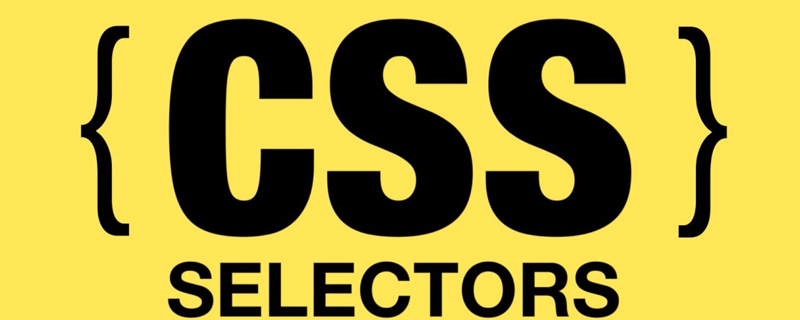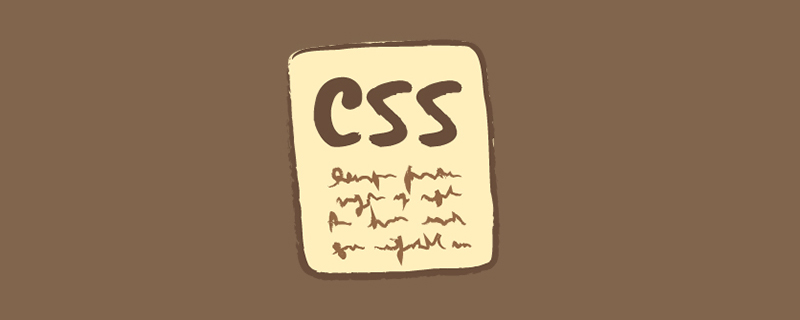Selector styles include element selector, class selector, ID selector, attribute selector, pseudo-class selector, pseudo-element selector, descendant selector, child element selector, adjacent sibling selector and universal sibling selectors etc. Detailed introduction: 1. Element selector, select elements through the tag name of HTML elements, you can use the element selector to apply the same style to all elements of the same type; 2. Class selector, select elements through the class attribute of the element, use " ." symbol to represent a class selector; you can use a class selector to group a group with the same characteristics, etc.

The operating system for this tutorial: Windows 10 system, DELL G3 computer.
Selector style refers to using selectors in CSS to select elements and apply styles to these elements. CSS provides a variety of selector styles. The following are some commonly used selector styles:
1. Element Selector (Element Selector): Select elements through the tag names of HTML elements. For example, the p selector selects all paragraph elements. You can use element selectors to apply the same style to all elements of the same type.
2. Class Selector: Select elements through their class attributes. Use the "." symbol to represent class selectors. For example, .red will select elements with the class attribute "red". You can use class selectors to apply the same style to a group of elements with the same characteristics.
3. ID Selector: Select elements through their id attribute. Use the "#" symbol to represent ID selectors. For example, #header selects elements with the id attribute "header". ID selectors have higher priority and can be used to apply specific styles to specific elements.
4. Attribute Selector: Select elements through their attributes. For example, [type="text"] will select all elements whose type attribute value is "text". Attribute selectors can select elements based on their attribute values and apply styles to them.
5. Pseudo-class Selector: Select elements through their special status. Pseudo-class selectors start with ":". For example, a:hover selects the mouse-over state of a link. Pseudo-class selectors can apply styles to specific states of elements, such as hover, click, etc.
6. Pseudo-element Selector: Select a specific part of the element. Pseudo-element selectors start with "::". For example, ::before selects content inserted before the element. Pseudo-element selectors can be used to apply styles to specific parts of an element, such as inserting content before the element.
7. Descendant Selector: Select elements through their descendant relationship. Use spaces to indicate descendant selectors. For example, div p will select all paragraph elements inside the div element. Descendant selectors select elements that are descendants of an element and apply styles to them.
8. Child Selector: Select elements through their direct child element relationship. Use the ">" symbol to represent child element selectors. For example, ul > li will select the direct child element li under the ul element. Child selectors select the direct children of an element and apply styles to them.
9. Adjacent Sibling Selector: Selects the sibling element immediately following the specified element. Use the " " notation to represent adjacent sibling selectors. For example, h1 p will select the paragraph element immediately following the h1 element. The neighbor selector selects an element's neighbor elements and applies styles to them.
10. General Sibling Selector: Selects all sibling elements that have the same parent element as the specified element and are behind the specified element. Use the "~" symbol to represent a universal sibling selector. For example, h1 ~ p will select all paragraph elements that have the same parent element as the h1 element and are behind the h1 element. The universal sibling selector selects an element's universal siblings and applies styles to them.
In addition to the common selector styles listed above, there are some other selector styles, such as parent element selector, space selector, etc. Different selector styles can be combined for more precise element selection and style application.
It should be noted that the more specific the selection range of the selector style, the higher the priority. When writing CSS styles, you should choose the appropriate selector style according to specific needs to ensure that the style can be accurately applied to the target element. At the same time, you should also pay attention to the performance of the selector style to avoid rendering performance degradation caused by overly complex selectors.
To summarize, CSS provides a variety of selector styles, including element selectors, class selectors, ID selectors, attribute selectors, pseudo-class selectors, pseudo-element selectors, descendant selectors, and child selectors. Element selectors, adjacent sibling selectors, universal sibling selectors, etc. By rationally using these selector styles, you can accurately select elements and apply styles to achieve rich and diverse page layouts and effects.
The above is the detailed content of What are the selector styles?. For more information, please follow other related articles on the PHP Chinese website!
 css中id选择符的标识是什么Sep 22, 2022 pm 03:57 PM
css中id选择符的标识是什么Sep 22, 2022 pm 03:57 PM在css中,id选择符的标识是“#”,可以为标有特定id属性值的HTML元素指定特定的样式,语法结构“#ID值 {属性 : 属性值;}”。ID属性在整个页面中是唯一不可重复的;ID属性值不要以数字开头,数字开头的ID在Mozilla/Firefox浏览器中不起作用。
 使用:nth-child(n+3)伪类选择器选择位置大于等于3的子元素的样式Nov 20, 2023 am 11:20 AM
使用:nth-child(n+3)伪类选择器选择位置大于等于3的子元素的样式Nov 20, 2023 am 11:20 AM使用:nth-child(n+3)伪类选择器选择位置大于等于3的子元素的样式,具体代码示例如下:HTML代码:<divid="container"><divclass="item">第一个子元素</div><divclass="item"&
 css伪选择器学习之伪类选择器解析Aug 03, 2022 am 11:26 AM
css伪选择器学习之伪类选择器解析Aug 03, 2022 am 11:26 AM在之前的文章《css伪选择器学习之伪元素选择器解析》中,我们学习了伪元素选择器,而今天我们详细了解一下伪类选择器,希望对大家有所帮助!
 javascript选择器失效怎么办Feb 10, 2023 am 10:15 AM
javascript选择器失效怎么办Feb 10, 2023 am 10:15 AMjavascript选择器失效是因为代码不规范导致的,其解决办法:1、把引入的JS代码去掉,ID选择器方法即可有效;2、在引入“jquery.js”之前引入指定JS代码即可。
 从入门到精通:掌握is与where选择器的使用技巧Sep 08, 2023 am 09:15 AM
从入门到精通:掌握is与where选择器的使用技巧Sep 08, 2023 am 09:15 AM从入门到精通:掌握is与where选择器的使用技巧引言:在进行数据处理和分析的过程中,选择器(selector)是一项非常重要的工具。通过选择器,我们可以按照特定的条件从数据集中提取所需的数据。本文将介绍is和where选择器的使用技巧,帮助读者快速掌握这两个选择器的强大功能。一、is选择器的使用is选择器是一种基本的选择器,它允许我们根据给定条件对数据集进
 css中的选择器包括超文本标记选择器吗Sep 01, 2022 pm 05:25 PM
css中的选择器包括超文本标记选择器吗Sep 01, 2022 pm 05:25 PM不包括。css选择器有:1、标签选择器,是通过HTML页面的元素名定位具体HTML元素;2、类选择器,是通过HTML元素的class属性的值定位具体HTML元素;3、ID选择器,是通过HTML元素的id属性的值定位具体HTML元素;4、通配符选择器“*”,可以指代所有类型的标签元素,包括自定义元素;5、属性选择器,是通过HTML元素已经存在属性名或属性值来定位具体HTML元素。
 深度解析is与where选择器:提升CSS编程水平Sep 08, 2023 pm 08:22 PM
深度解析is与where选择器:提升CSS编程水平Sep 08, 2023 pm 08:22 PM深度解析is与where选择器:提升CSS编程水平引言:在CSS编程过程中,选择器是必不可少的元素。它们允许我们根据特定的条件选择HTML文档中的元素并对其进行样式化。在这篇文章中,我们将深入探讨两个常用的选择器,即:is选择器和where选择器。通过了解它们的工作原理和使用场景,我们可以大大提升CSS编程的水平。一、is选择器is选择器是一个非常强大的选择
 wxss选择器有哪些Sep 28, 2023 pm 04:27 PM
wxss选择器有哪些Sep 28, 2023 pm 04:27 PMwxss选择器有元素选择器、类选择器、ID选择器、伪类选择器、子元素选择器、属性选择器、后代选择器和通配选择器等。详细介绍:1、元素选择器,使用元素名称作为选择器,选取匹配的元素,使用“view”选择器可以选取所有的“view”组件;2、类选择器,使用类名作为选择器,选取具有特定类名的元素,使用“.classname”选择器可以选取具有“.classname”类名的元素等等。

Hot AI Tools

Undresser.AI Undress
AI-powered app for creating realistic nude photos

AI Clothes Remover
Online AI tool for removing clothes from photos.

Undress AI Tool
Undress images for free

Clothoff.io
AI clothes remover

AI Hentai Generator
Generate AI Hentai for free.

Hot Article

Hot Tools

PhpStorm Mac version
The latest (2018.2.1) professional PHP integrated development tool

VSCode Windows 64-bit Download
A free and powerful IDE editor launched by Microsoft

WebStorm Mac version
Useful JavaScript development tools

Dreamweaver CS6
Visual web development tools

SublimeText3 Mac version
God-level code editing software (SublimeText3)






